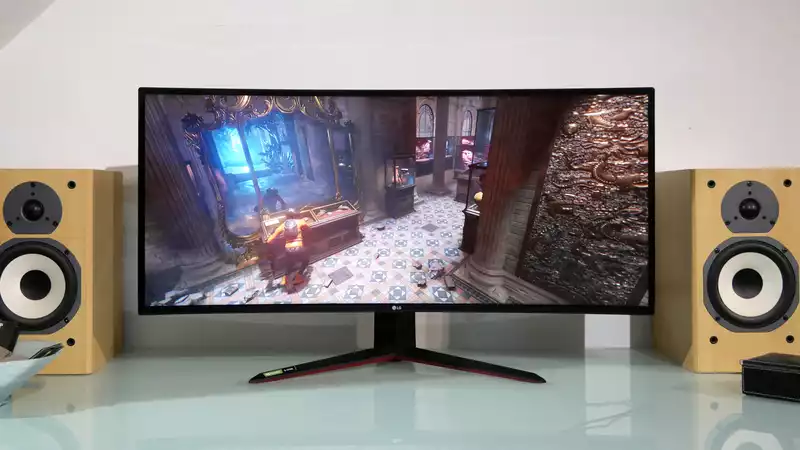The rapid adoption of ultrawide monitors with a 21:9 aspect ratio is remarkable. While there is now a 49-inch ultrawide 32:9 aspect beast on the market, the new LG UltraGear 34GN850 34-inch 21:9 effort has most of the qualities of a mainstream monitor these days.
Almost, but not quite. That's because this panel is aggressively packed with the latest features, all of which start with the 34-inch curved screen, and if 3,440 x 1,440 pixels is on par for this kind of display, the Nano IPS technology that enables 1 ms is quite a trick.
LG is one of the few monitor manufacturers that actually manufactures LCD panels and offers products produced in-house. In this case, LG believes that Nano IPS technology is comparable in speed to TN. This is important because the 34GN850 supports a 160 Hz refresh rate and older IPS panels cannot keep up in terms of responsiveness.
Next up is HDR support. However, it is only VESA DisplayHDR400, which is the lowest level of HDR certification. Therefore, there is no local dimming and peak brightness is 400 nits at best. However, even the lowest HDR panels tend to pack a bit more punch than SDR panels; the ability to correctly process HDR video streams and render HDR games is also at least useful. [The 34GN850 also supports both Nvidia G-Sync and AMD FreeSync Premium; G-Sync support is G-Sync Compatible Verified rather than full G-Sync, so Nvidia's processing chip Note that the set itself is lacking. Overall, however, it is a comprehensive and outstandingly game-centric feature set.
If you're looking for missing, the only really obvious omission is the USB Type-C connection. In other words, you can't use a single cable to connect the laptop to drive the display, charge the battery, or connect peripherals. Given the gaming-centric nature of the product, one might assume that most buyers will be using desktops. Perhaps that is true. Furthermore, a truly powerful gaming portable will require more charge than a typical USB-C interface can provide.
And since USB-C is such a great feature, it is hard to completely overlook its omission.
Those details aside, the LG 34GN850's design aesthetic strikes a nice balance between conveying that it's serious about gaming and not being too business-like. There's glossy black plastic and understated red accents, but nothing overly adolescent. We like it. Incidentally, the stand is adjustable for height and tilt and includes a two-port USB 3.1 hub.
Speaking of things we like, how about the LG 34GN850's picture quality right out of the box? The static contrast of the nano IPS panel is only 1,000:1. This can lead to image bleaching and IPS glow, a problem that some LG IPS monitors have. But not here. This 34-inch is rich, vibrant, saturated, punchy, and contrasty.
As for core image quality, it's all good stuff.
Of course, it is not perfect. For example, there are noticeable sparkles and halos around bright objects placed against dark backgrounds. And while HDR content looks great, this display does not have the same shocking visual impact as a true HDR panel with local dimming and much higher brightness.
Another area of debate is pixel response. To be clear, it is excellent by IPS standards. It is almost on par. However, setting the pixel overdrive to the highest level produces noticeable reverse ghosting, which is not a major issue since LG offers three levels of overdrive and the middle setting produces great response but little to no ghosting.
Does it rival the fastest TN monitors? No. The reality is that when it comes to LCD technology, you can't have it all on every monitor. If you want the fastest response, you have to put up with TN, which has relatively poor contrast, color, and viewing angles.
Us. With luscious colors and impeccable viewing angles, we'd take this IPS screen any day. [The LG 34GN850's mere 160Hz refresh would have seemed spectacularly fast a few years ago. But now that 240Hz screens are all but established and 360Hz is on the horizon, is 160Hz still a big draw? beyond 120Hz, refresh rates usually yield less. esports enthusiasts who want to maintain CS:GO's reputation will want something faster. You'll want it. If you're anyone else, this monitor hits buttery smooth frame rates. [That is, of course, if you have the GPU to drive it; 3,440 x 1,440 is not a huge native resolution by today's standards. But to drive this at 160 Hz on the latest and greatest titles is no mean feat. But if you have the hardware for it, you will enjoy it. Old-school adventures like "The Witcher 3" look really sweet on this panel. And even a strategy-oriented title like the "Total War" series offers a great experience with ample size and detail. Likewise, aside from the aforementioned semi-pro esports types, this is a great screen for CS:Go and Battle Royale.
Of course, being essentially a $1,000 or £1,000 screen, it has to be. This is where our main reservation comes into the story. This screen is an all-around great screen for gaming, video, and productivity. But is it a $1,000 experience? This is a difficult decision, as high-resolution 4K monitors, albeit 27 inches, are available for less. Certainly at this price, it should have a high HDR grade with local dimming capabilities and USB-C, which might make it feel like a true premium display.
.

Comments